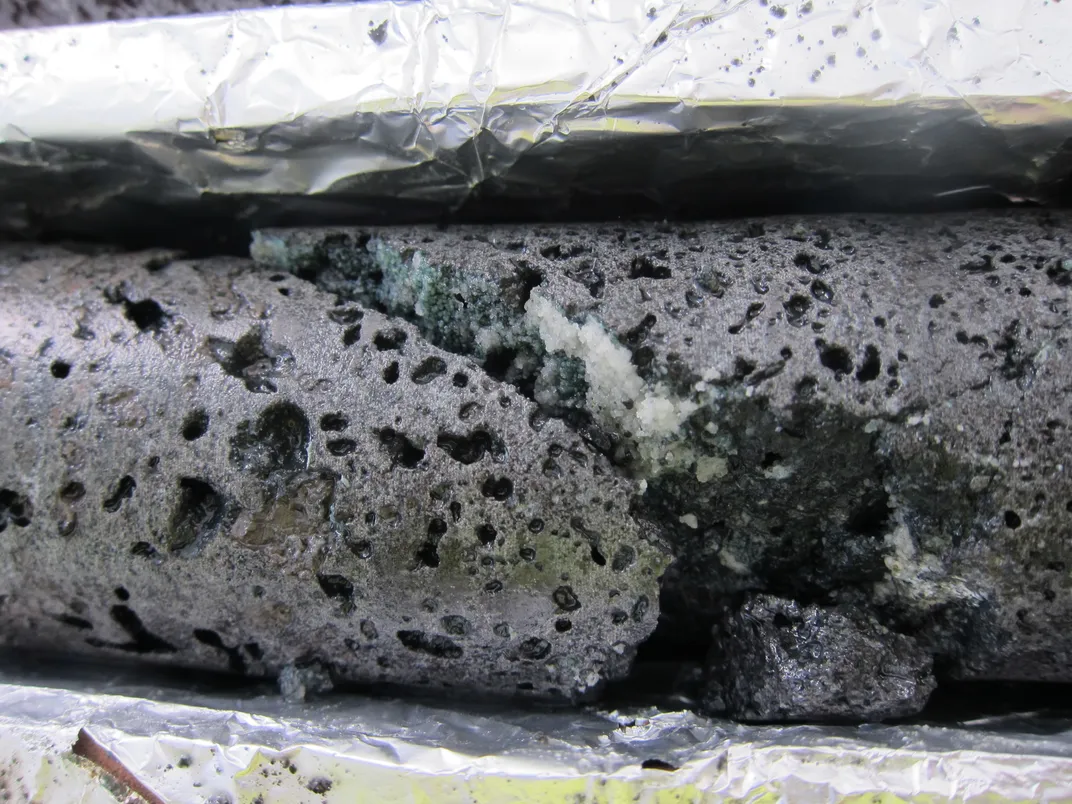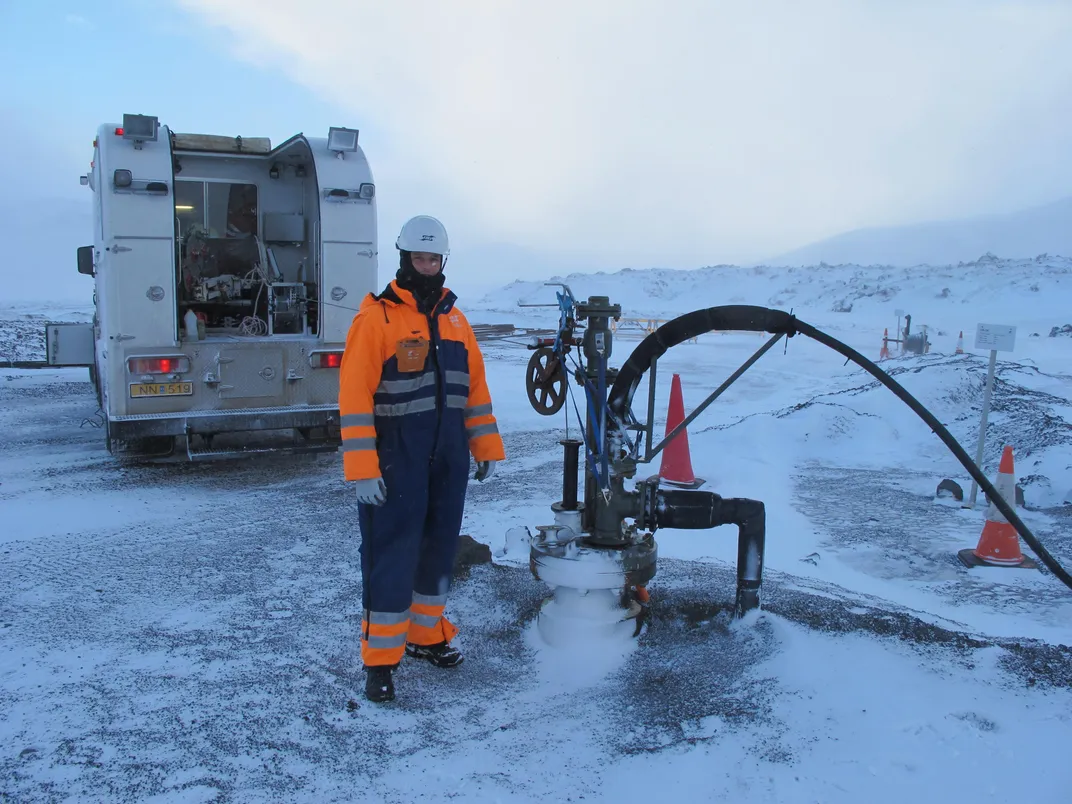Iceland Carbon Capture Project Quickly Converts Carbon Dioxide Into Stone
More than 95 percent of gas injected into the ground precipitated out as harmless carbonate, scientists calculate
/https://tf-cmsv2-smithsonianmag-media.s3.amazonaws.com/filer/01/c3/01c3025d-7234-4247-bdef-daa0b2127217/matter1hr.jpg)
A pilot project that sought to demonstrate that carbon dioxide emissions could be locked up by turning them into rock appears to be a success. Tests at the CarbFix project in Iceland indicate that most of the CO2 injected into basalt turned into carbonate minerals in less than two years, far shorter a time than the hundreds or thousands of years that scientists had once thought such a process would take.
“This project shows that, in fact, CO2 most likely turns into carbonates in a relatively modest amount of time,” notes David Goldberg, a geophysicist at the Lamont-Doherty Earth Observatory of Columbia University who was not involved with the project. “That’s a significant outcome.”
Most conventional carbon capture and storage projects inject liquefied carbon dioxide into sedimentary rocks, the type of rocks in which oil and natural gas are found. Because oil and gas companies have so much experience working with these types of rocks, they are a natural place to store CO2. But these types of formations can only store the gas, not turn it into rock. And there is always a danger that the gas could escape to the atmosphere and add to global climate change.
The mineralogy of basalts, though, is very favorable for locking up carbon dioxide, says Juerg Matter, a geochemist now at the University of Southampton who began working on the CarbFix project while at Lamont-Doherty. For carbon dioxide to transform into carbonate, the rocks into which the gas is injected need to have calcium-, magnesium- or iron-rich silicate minerals. A chemical reaction then occurs that converts the carbon dioxide and minerals into a chalky carbonate mineral. Sedimentary rocks don’t have much of those minerals, but basalts—a type of volcanic rock that makes up most of the ocean floor as well as rocks on some other places on land—have plenty. Scientists figured that they should be able to lock away CO2 in such rocks as carbonate, but first they had to prove that it would work—and on a reasonable timescale.

In 2012, scientists injected 230 tons of carbon dioxide into basalt rocks near the Hellisheidi geothermal plant east of Reykjavik. Unlike in more conventional carbon storage facilities, the gas was first dissolved into water (creating something like Perrier, notes Goldberg).
Because seeing what is going on underground is difficult, the scientists also included a set of tracers that would later allow them to see the fate of that CO2. First, they included two chemicals, sulfur hexafluoride and trifluoromethyl sulfur pentafluoride, that let them trace the movement of the injected fluid underground. And they also added a small amount of radioactive carbon-14 to their carbon dioxide mix.
“It’s kind of a smart tracer,” Matter says. “In deep reservoirs, like the one we used to store CO2, all the carbon that preexisted in the reservoir before the injection has no radiocarbon in it. It’s too old.” So when the team later went looking for carbonate, if it had radiocarbon, the researchers knew that it most likely came from the gas they injected.
Those tracers let the scientists quantify what happened to the carbon dioxide after the injection. More than 95 percent turned into carbonate within the following two years, they report today in Science.
“The results are very encouraging,” says Peter McGrail, an environmental engineer at the Pacific Northwest National Laboratory. “They’ve done a pretty excellent job in terms of the design of that field study,” he says, and particularly with the use of the two methods of tracing the fate of the carbon.
McGrail is heading up a similar project that injected supercritical—liquid—carbon dioxide into basalt rocks near Wallula, Washington. The outcome of that project will be published soon, but McGrail says that his group is seeing similar results to what the CarbFix project has found.

While these results are promising, questions remain about whether the technology can be scaled up to industrial-size storage, socking away a million tons of carbon dioxide or more. (That's not much in terms of overall global emissions, which are hovering around 38 billion tons a year.) The CarbFix method would require a lot of water at that scale. And both of the basalt pilot projects can’t predict if the necessary chemical reactions will be sustained underground with so much more carbon dioxide, McGrail says.
Matter notes that 10,000 tons of carbon dioxide have now been injected into another site in Iceland, but testing larger quantities there would be difficult because “there’s not that much CO2 in Iceland.” It’s a small country with relatively small carbon emissions.
Cost also remains a concern. The CarbFix method costs much more than conventional carbon capture and storage methods, but it wouldn’t require the same kind of extensive monitoring since there would be little risk of gas leakage. Without any kind of political or economic framework for storing carbon, however, this is all moot. Right now, Matter notes, “it’s free to pollute the atmosphere.”
But should such incentives be implemented, carbon capture and storage, in all its forms, could become a bigger part in how humans deal with the problem of greenhouse gases, both Goldberg and Matter say. “It’s not a silver bullet solution,” Matter says, but it could provide a bridge between our fossil-fuel past and a renewable energy future.
/https://tf-cmsv2-smithsonianmag-media.s3.amazonaws.com/accounts/headshot/Sarah-Zielinski-240.jpg)
/https://tf-cmsv2-smithsonianmag-media.s3.amazonaws.com/accounts/headshot/Sarah-Zielinski-240.jpg)